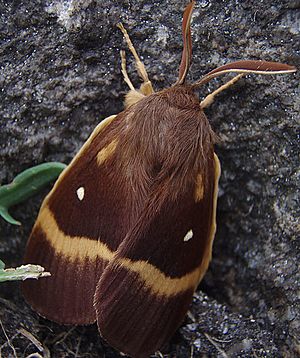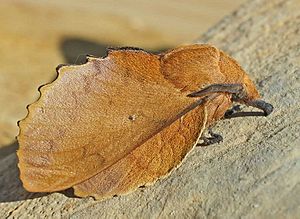List of moths of Great Britain (Lasiocampidae) facts for kids
The family Lasiocampidae is a group of moths often called eggar moths. These moths are known for their fuzzy bodies and often dull colors like brown, grey, or yellow. In Great Britain, there are about 10 types of eggar moths that live there all the time. One type is probably extinct, meaning it's no longer found, and another is a rare immigrant that visits from other places.
Eggar moths get their name possibly because their cocoons look like eggs, or because their eggs are laid in neat, egg-shaped clusters. Their caterpillars are often very hairy and can sometimes cause a mild skin irritation if touched, so it's best to look but not touch!
Meet the Eggar Moths of Great Britain
Here are some of the interesting eggar moths you might find in Great Britain:
- Poecilocampa populi, the December moth — You can find this moth almost everywhere in Great Britain. It's special because it flies late in the year, even in December!
- Trichiura crataegi, the pale eggar — This moth is also found all over, but it's considered vulnerable, meaning its numbers are getting lower.
- Eriogaster lanestris, the small eggar — This one lives in the south and central parts of Great Britain. It's a bit rarer than the common types.
- Malacosoma neustria, the lackey — This moth is common in the south and central areas, but you can also find it scattered in the north. It's also considered vulnerable.
- Malacosoma castrensis, the ground lackey — This type is found in the south-east and south-west of Great Britain and is quite rare.
- Lasiocampa trifolii, the grass eggar — You can spot this moth in the south and west-central regions. There's a special pale yellow form called Lasiocampa trifolii f. flava (pale grass eggar) that is very rare and mostly found in the south-east.
- Lasiocampa quercus, the oak eggar — This is a well-known eggar moth.
- Lasiocampa quercus quercus — This type lives in the south and central areas.
- Lasiocampa quercus f. callunae (northern eggar) — This form is found in the north and west.
- Macrothylacia rubi, the fox moth — You can find this moth throughout Great Britain. Its caterpillars are often seen in late summer.
- Dendrolimus pini, the pine-tree lappet — This is a rare visitor to Great Britain, usually coming from other countries.
- Euthrix potatoria, the drinker — This moth is found in the south, central, and north-west parts of the country. Its caterpillars are sometimes called "drinkers" because they seem to drink dew drops.
- Phyllodesma ilicifolia, the small lappet — Sadly, this moth is thought to be extinct in Great Britain, meaning it's no longer living there.
- Gastropacha quercifolia, the lappet — This moth lives in the south and east-central areas.
Some of these moths are listed in the UK Biodiversity Action Plan (BAP). This plan helps protect species that are rare or whose numbers are declining, making sure they have a safe future.
Life Cycle of Eggar Moths
Like all moths, eggar moths go through a fascinating life cycle with four main stages:
- Egg: The female moth lays tiny eggs, often in clusters on plants.
- Larva (Caterpillar): The eggs hatch into caterpillars. These caterpillars are usually quite hairy and spend their time eating leaves, growing bigger with each meal. They shed their skin several times as they grow.
- Pupa (Cocoon): Once a caterpillar is fully grown, it forms a cocoon. This is a protective casing where it transforms into an adult moth. Many eggar moth cocoons are tough and look a bit like an egg.
- Adult Moth: Finally, the adult moth emerges from the cocoon. Adult moths usually live for a short time, just long enough to find a mate and lay eggs, starting the cycle all over again.
See also
- List of moths of Great Britain (overview)
- Family lists: Hepialidae, Cossidae, Zygaenidae, Limacodidae, Sesiidae, Lasiocampidae, Saturniidae, Endromidae, Drepanidae, Thyatiridae, Geometridae, Sphingidae, Notodontidae, Thaumetopoeidae, Lymantriidae, Arctiidae, Ctenuchidae, Nolidae, Noctuidae and Micromoths




